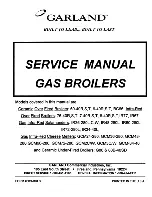
19
INST
INST
INST
INST
INSTALLA
ALLA
ALLA
ALLA
ALLATION 5
TION 5
TION 5
TION 5
TION 5
5-5.5 Pressure Relief Valve
The Pressure Relief Valve is provided to vent excess pressure from the system. The valve
will open when the pressure exceeds 3 Bar ± 10%.
The pressure relief valve can be manually opened by turning the red knob clockwise, to
close the valve continue turning clockwise until it clicks.
5-5.6 Pressure Relief Valve Discharge Pipe
The outlet from the pressure relief valve must be piped using 15mm copper pipe to a
visible position outside the dwelling by the installer. The pipe must have a continuous
fall and ideally be terminated over a drain.
Local by-laws may require a Tundish to be fitted.
Knockouts are provided for the vent pipe in the back panel and in the flue blanking plates
each side of the Boiler, see fig. 5-5c.
IMPORTANT
Scalding water and steam can be blown out of the discharge pipe.
Position the discharge so that it is not a hazard to property or people
(especially children).
5-5.7 Expansion Vessel
Maximum charge pressure
1.5 Bar
Maximum working temperature
90°C
Pre-charge pressure
1 Bar
Maximum working pressure
3Bar
Capacity
OS60/80, OS80/95 & OS90/120 10 litres - for maximum system expansion of 9 litres.
OS100/150
20 litres - for maximum system expansion of 18 litres.
The expansion vessel supplied is suitable for systems with a static head of up to 5
metres. If the static head is greater than 5 metres the charge pressure of the expansion
vessel will need to be increased. Increase the pressure using a standard car tyre pump
and pressure gauge when the system is empty (zero pressure).
Expansion vessels are suitable for systems requiring a maximum expansion of 9 or 18
litres as detailed above. For systems requiring more expansion a second expansion
vessel will be required. BS7074 Part 1 includes information on this requirement.
5-5.8 Filling Loop
A Filling Loop comprising a flexible hose, double check valve and an isolating valve is
supplied for filling and topping up the system.
The filling loop should be fitted between the incoming mains and the heating system
return as shown in fig. 5-5e.
When not in use one of the hose unions must be disconnected as there must not be a
permanent connection to the mains supply.
OS60/80 & OS80/95 SHOWN
Fig. 5-5c Discharge Pipe
Fig. 5-5d Static Head
Fig. 5-5e Filling Loop
MAINS
SUPPLY
ISOLATING VALVE
SUPPLIED
FLEXIBLE HOSE
SUPPLIED
DOUBLE CHECK VALVE
SUPPLIED
HEATING
RETURN
HOSE MUST BE
DISCONNECTED WHEN
NOT IN USE
TYPICAL ARRANGEMENT
Note
Normally expansion requirement is 4% of
the system water content including the
Boiler.
HIGHEST POINT OF SYSTEM
EXPANSION VESSEL
STATIC HEAD
55555
















































